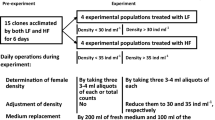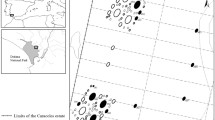Abstract
Monogonont rotifers live in habitats that display extensively variation in both biotic and abiotic components. Much of this variation is seasonal and therefore predictable for a given pond or lake. In 1972, King proposed one physiological and two genetic models presenting alternative modes of adaptation to this temporal variation. Our purpose in the present paper is to review and evaluate how our knowledge of the seasonal structure of rotifer populations has changed in the past 25 years. Seasonal changes in clone frequencies have been reported from three studies of natural populations using electrophoretic analysis of isozymes. In one of these studies there was evidence for substantial temporal overlap of multilocus genotypes suggesting that these clones were broad-niched generalists. By contrast, both the genetic and ecological analyses in the other two studies support a non-overlap model in which clonal groups are composed of narrow-niched specialists that undergo seasonal succession. In both of these studies the clonal groups appear to have achieved the status of sibling species, a phenomenon that we conclude is probably common in monogonont rotifers. Strong competition promotes reproductive isolation between successive groups of seasonal specialists. The existence of this competition has been inferred from natural populations and demonstrated by studies in the laboratory. Also required, and also supported by field observations, is a temporal separation of periods of mictic (sexual) reproduction. A final requirement of the nonoverlap model is seasonal variation in the timing of resting egg hatching. That is, clones established from hatching of resting eggs must enter a physiologically appropriate habitat if they are to increase in number and achieve a competitive advantage. Unfortunately, we still have little information on this topic. Finally, we present the results of a study analyzing the effects of variation in the mictic ratio (i.e., the relative frequency of mictic females) on the adaptive structure of rotifer populations. Mixis may shift the balance between costs and benefits of specialization thereby producing seasonally specialized populations that overlap in space but not time. Life history patterns may therefore provide fundamental insights on the adaptation of rotifers to the extensive temporal variation in their environments.
Similar content being viewed by others
References
Arndt, H., 1991a. Population ecology of estuarine rotifers in an inlet of the Southern Baltic (Abstract). VI International Rotifer Symposium, Banyoles, Spain: 83.
Arndt, H., 1991b. Population dynamics and production of estuarine planktonic rotifers in the Southern Baltic: Brachionus quadridentatus. Acta Ichthiol. Piscatoria (Szczecin) 21: 7–15.
Black, R. W. II & L. B. Slobodkin, 1987. What is cyclomorphosis? Freshwat. Biology 18: 373–378.
Clarke, B., C. Diver & J. Murray, 1968. Studies on Cepaea. VI. The spatial and temporal distribution of phenotypes in a colony of Cepaea nemoralis (L.). Proc. r. Soc. B. 253: 521–548.
Gómez, A., 1996. Ecología genética y sistemas de reconocimiento de pareja en poblaciones simpátricas de rotíferos. Ph. D. Thesis. Universitat de València, Valencia.
Gómez, A., & M. Serra, 1995. Behavioral reproductive isolation among sympatric strains of the rotifer Brachionus plicatilis Müller 1786: insights into the status of this taxonomic species. Hydrobiologia 313/314: 111–119.
Gómez, A. & T. W. Snell, 1996. Sibling species and cryptic speciation in the Brachionus plicatilis species complex (Rotifera). J. Evol. Biol. 9: 953–964.
Gómez, A., M. Temprano & M. Serra, 1995. Ecological genetics of a cyclical parthenogen in temporary habitats. Journal of Evolutionary Biology 8: 601–622.
Gómez, A., M. J. Carmona & M. Serra, 1997. Ecological factors affecting mate system in the Brachionus plicatilis complex (rotifera). Oecologia 111: 350–356.
Hedrick, P. W., S. Jain & L. Holden, 1978. Multilocus systems in evolution. Evol. Biol. 11: 101–182.
King, C. E., 1972. Adaptation of rotifers to seasonal variation. Ecology 53: 408–418.
King, C. E., 1977. Genetics of reproduction, variation and adaptation in rotifers. Archiv für Hydrobiol. Beih. 8: 187–201.
King, C. E., 1980. The genetic structure of zooplankton populations. In Kerfoot, W. C. (ed.), Evolution and Ecology of Zooplankton communities. The University Press of New England, Hanover, NH, U.S.A.: 315–328.
King, C. E., 1982. The evolution of life span. In Dingle, H. & J. P. Hegman (eds), Evolution and Genetics of Life Histories. Springer-Verlag, New York: 121–138.
King, C. E., 1993. Random genetic drift during cyclical ameiotic parthenogenesis. Hydrobiologia 255/256: 205–212.
King, C. E. & T. W. Snell, 1977. Sexual recombination in rotifers. Heredity 39: 357–360.
King, C. E. & T. W. Snell, 1980. Density-dependent sexual reproduction in natural populations of the rotifer Asplanchna girodi. Hydrobiologia 73: 149–152.
King, C. E. & Y. Zhao, 1987. Coexistence of rotifer (Brachionus plicatilis) clones in Soda Lake, Nevada. Hydrobiologia 147: 57- 64.
Lynch, M., 1983. Ecological genetics of Daphnia pulex. Evolution 37: 358–374.
Lynch, M., 1985. Speciation in Cladocera. Verh. int. Ver. Limnol. 22: 3116–3123.
Marcus, N. H., R. Luz, W. Burnett & P. Cable, 1994. Age, viability, and vertical distribution of zooplankton resting eggs from an anoxic basin: evidence of an egg bank. Limnol. Oceanogr. 39: 154–158.
May, L., 1987. Effect of incubation temperature on the hatching of rotifer resting eggs collected from sediment. Hydrobiologia 147: 335–338.
MacArthur, R. H. & R. Levins, 1967. The limiting similarity, convergence and divergence of coexisting species. American Naturalist 101: 377–385.
Maynard Smith, J., 1978. The Evolution of Sex. Cambridge University Press, Cambridge: 222 pp.
Nogrady, T., R. L. Wallace & T.W. Snell, 1993. Rotifera: Volume 1: Biology, Ecology, and Systematics. SPB Academic Publishing, The Hague: 137 pp.
Pourriot, R. & T. W. Snell, 1983. Resting eggs in rotifers. Hydrobiologia 104: 213–224.
Rico-Martinez, R. & T. W. Snell, 1995. Mating behavior and mate recognition pheromone blocking of male receptors in Brachionus plicatilis Müller (Rotifera). Hydrobiologia 313/314: 105–110.
Rothhaupt, K. O., 1988. Mechanistic resource competition theory applied to laboratory experiments with zooplankton. Nature 333: 660–662.
Serra, M. & C. E. King, Optimal rates of bisexual reproduction in cyclical parthenogens with density-dependent growth. J. Evol. Biol. in press.
Snell, T. W., 1979. Intraspecific competition and population structure in rotifers. Ecology 60: 494–502.
Snell, T. W., 1980. Blue-green algae and selection in rotifer populations. Oecologia 46: 343–346.
Snell, T. W. & E. M. Boyer, 1988. Thresholds for mictic female production in the rotifer Brachionus plicatilis (Müller). J. exp. mar. Biol. Ecol. 124: 73–85.
Snell, T.W. & B. L. Garman, 1986. Encounter probabilities between male and female rotifers. J. exp. mar. Biol. Ecol. 97: 221–230.
Snell, T. W. & F. H. Hoff, 1985. The effect of environmental factors on resting egg production in the rotifer Brachionus plicatilis. J. World Mar. Soc. 16: 484–497.
Snell, T. W. & C. E. King, 1977. Lifespan and fecundity patterns in rotifers: the cost of reproduction. Evolution 31: 882–890.
Snell, T. W. & P. D. Morris, 1993. Sexual communication in copepods and rotifers. Hydrobiologia 255/256: 109–116.
Snell, T. W., M. J. Childress & B. C. Winkler, 1988. Characteristics of the mate recognition factor in the rotifer Brachionus plicatilis. Comp. Biochem. Physiol. 89: 481–485.
Snell, T. W., R. Rico-Martinez, L. N. Kelly & T. E. Battle, 1995. Identification of a sex pheromone from a rotifer. Mar. Biol. 123: 347–353.
Walsh, E. J., 1992. Ecological and genetic aspects of the population biology of the littoral rotifer Euchlanis dilatata. Ph.D. Dissertation, University of Nevada, Las Vegas.
Walsh, E. J., 1995. Habitat-specific predation susceptibilities of a littoral rotifer to two invertebrate predators. Hydrobiologia 313/314: 205–211.
Walsh, E. J. & L. Zhang, 1992. Polyploidy and body size variation in a natural population of the rotifer Euchlanis dilatata. J. Evol. Biol. 5: 345–353.
Williams, G. C., 1975. Sex and Evolution. Princeton University Press, Princeton, N.J.: 200 pp.
Zhao, Y. & C. E. King, 1989. Ecological genetics of the rotifer Brachionus plicatilis in Soda Lake, Nevada, USA. Hydrobiologia 185: 175–181.
Author information
Authors and Affiliations
Rights and permissions
About this article
Cite this article
King, C.E., Serra, M. Seasonal variation as a determinant of population structure in rotifers reproducing by cyclical parthenogenesis. Hydrobiologia 387, 361–372 (1998). https://doi.org/10.1023/A:1017040004978
Issue Date:
DOI: https://doi.org/10.1023/A:1017040004978




